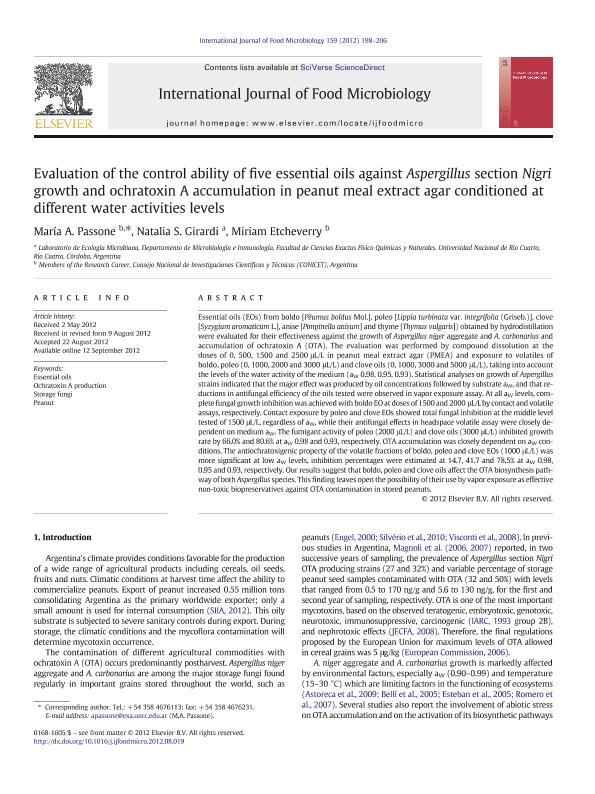Mostrar el registro sencillo del ítem
dc.contributor.author
Passone, Maria Alejandra

dc.contributor.author
Girardi, Natalia Soledad

dc.contributor.author
Etcheverry, Miriam Graciela

dc.date.available
2023-05-24T11:46:31Z
dc.date.issued
2012-10
dc.identifier.citation
Passone, Maria Alejandra; Girardi, Natalia Soledad; Etcheverry, Miriam Graciela; Evaluation of the control ability of five essential oils against Aspergillus section Nigri growth and ochratoxin A accumulation in peanut meal extract agar conditioned at different water activities levels; Elsevier Science; International Journal of Food Microbiology; 159; 3; 10-2012; 198-206
dc.identifier.issn
0168-1605
dc.identifier.uri
http://hdl.handle.net/11336/198536
dc.description.abstract
Essential oils (EOs) from boldo [Pëumus boldus Mol.], poleo [Lippia turbinata var. integrifolia (Griseb.)], clove [Syzygium aromaticum L.], anise [Pimpinella anisum] and thyme [Thymus vulgaris]) obtained by hydrodistillation were evaluated for their effectiveness against the growth of Aspergillus niger aggregate and A. carbonarius and accumulation of ochratoxin A (OTA). The evaluation was performed by compound dissolution at the doses of 0, 500, 1500 and 2500 μL/L in peanut meal extract agar (PMEA) and exposure to volatiles of boldo, poleo (0, 1000, 2000 and 3000 μL/L) and clove oils (0, 1000, 3000 and 5000 μL/L), taking into account the levels of the water activity of the medium (aW 0.98, 0.95, 0.93). Statistical analyses on growth of Aspergillus strains indicated that themajor effect was produced by oil concentrations followed by substrate aW, and that reductions in antifungal efficiency of the oils tested were observed in vapor exposure assay. At all aW levels, complete fungal growth inhibitionwas achievedwith boldo EOat doses of 1500 and 2000 μL/L by contact and volatile assays, respectively. Contact exposure by poleo and clove EOs showed total fungal inhibition at the middle level tested of 1500 μL/L, regardless of aW, while their antifungal effects in headspace volatile assay were closely dependent on medium aW. The fumigant activity of poleo (2000 μL/L) and clove oils (3000 μL/L) inhibited growth rate by 66.0% and 80.6% at aW 0.98 and 0.93, respectively. OTA accumulation was closely dependent on aW conditions. The antiochratoxigenic property of the volatile fractions of boldo, poleo and clove EOs (1000 μL/L) was more significant at low aW levels, inhibition percentages were estimated at 14.7, 41.7 and 78.5% at aW 0.98, 0.95 and 0.93, respectively. Our results suggest that boldo, poleo and clove oils affect the OTA biosynthesis pathway of both Aspergillus species. This finding leaves open the possibility of their use by vapor exposure as effective non-toxic biopreservatives against OTA contamination in stored peanuts.
dc.format
application/pdf
dc.language.iso
eng
dc.publisher
Elsevier Science

dc.rights
info:eu-repo/semantics/openAccess
dc.rights.uri
https://creativecommons.org/licenses/by-nc-sa/2.5/ar/
dc.subject
ESSENTIAL OILS
dc.subject
OCHRATOXIN A PRODUCTION
dc.subject
PEANUT
dc.subject
STORAGE FUNGI
dc.subject.classification
Otras Ciencias Biológicas

dc.subject.classification
Ciencias Biológicas

dc.subject.classification
CIENCIAS NATURALES Y EXACTAS

dc.title
Evaluation of the control ability of five essential oils against Aspergillus section Nigri growth and ochratoxin A accumulation in peanut meal extract agar conditioned at different water activities levels
dc.type
info:eu-repo/semantics/article
dc.type
info:ar-repo/semantics/artículo
dc.type
info:eu-repo/semantics/publishedVersion
dc.date.updated
2023-05-18T14:04:28Z
dc.journal.volume
159
dc.journal.number
3
dc.journal.pagination
198-206
dc.journal.pais
Países Bajos

dc.journal.ciudad
Amsterdam
dc.description.fil
Fil: Passone, Maria Alejandra. Consejo Nacional de Investigaciones Científicas y Técnicas. Centro Científico Tecnológico Conicet - Córdoba; Argentina
dc.description.fil
Fil: Girardi, Natalia Soledad. Universidad Nacional de Río Cuarto. Facultad de Ciencias Exactas Fisicoquímicas y Naturales. Departamento de Microbiología e Inmunología. Cátedra de Ecología Microbiana; Argentina. Consejo Nacional de Investigaciones Científicas y Técnicas. Centro Científico Tecnológico Conicet - Córdoba; Argentina
dc.description.fil
Fil: Etcheverry, Miriam Graciela. Consejo Nacional de Investigaciones Científicas y Técnicas. Centro Científico Tecnológico Conicet - Córdoba; Argentina
dc.journal.title
International Journal of Food Microbiology

dc.relation.alternativeid
info:eu-repo/semantics/altIdentifier/url/https://www.sciencedirect.com/science/article/abs/pii/S0168160512004746
dc.relation.alternativeid
info:eu-repo/semantics/altIdentifier/doi/http://dx.doi.org/10.1016/j.ijfoodmicro.2012.08.019
Archivos asociados
